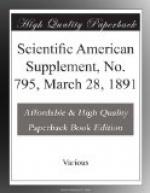* * * * *
THE SOURCE OF CHINESE GINGER.
In the Kew Bulletin for January an interesting account is given of the identification of the plant yielding the rhizome employed to make the well-known Chinese preserved ginger. As long ago as 1878 Dr. E. Percival Wright, of Trinity College, Dublin, called the attention of Mr. Thiselton Dyer to the fact that the preserved ginger has very much larger rhizomes than Zingiber officinale, and that it was quite improbable that it was the product of that plant. The difficulty in identifying the plant arose from the fact that, like many others cultivated for the root or tuber, it rarely flowers. The first flowering plant was sent to Kew from Jamaica by Mr. Harris, the superintendent of the Hope Garden there. During the past year the plant has flowered both at Dominica in the West Indies and in the Botanic Garden at Hong-Kong. Mr. C. Ford, the director of the Botanic Garden at Hong-Kong, has identified the plant as Alpinia Galanga, the source of the greater or Java galangal root of commerce. Mr. Watson, of Kew, appears to have been the first to suggest that the Chinese ginger plant is probably a species of Alpinia, and possibly identical with the Siam ginger plant, which was described by Sir J. Hooker in the Botanical Magazine (tab. 6,946) in 1887 as a new species under the name of Alpinia zingiberina. Mr. J.G. Baker, in working up the Scitamineae for the “Flora of British India,” arrived at the conclusion that it is not distinct from the Alpinia Galanga, Willd. The Siam and Chinese gingers are therefore identical, and both are the produce of Alpinia Galanga, Willd.
* * * * *
FLOATING ELEVATOR AND SPOIL DISTRIBUTOR.
We illustrate a floating elevator and spoil distributor constructed by Mr. A.F. Smulders, Utrecht, Holland, for removing dredged material out of barges at the Baltic Sea Canal Works. We give a perspective view showing the apparatus at work, and on a page plate are given plans, longitudinal and cross sections, with details which are from Engineering. The dredged material is raised out of the launches or barges by means of a double ranged bucket chain to a height of 10.5 meters (34 ft. 5 in.) above the water line, from whence it is pushed to the place of deposition by a heavy stream of water supplied by centrifugal pumps.
[Illustration: FLOATING ELEVATOR AND SPOIL DISTRIBUTOR FOR THE BALTIC SEA CANAL.]
The necessary machinery and superstructure are supported on two vessels connected, as shown in Figs. 4 and 5, with cross girders, a sufficient width being left between each vessel to form a well large enough for a barge to float into, and for the working of the bucket ladder utilized in raising the material from the barges. The girders are braced together and carry the framing for the bucket chains, gears, etc.




